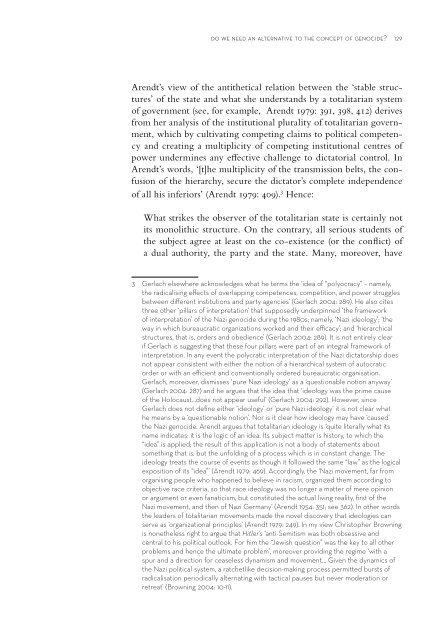60 years after the UN Convention - Dag Hammarskjöld Foundation
60 years after the UN Convention - Dag Hammarskjöld Foundation
60 years after the UN Convention - Dag Hammarskjöld Foundation
Create successful ePaper yourself
Turn your PDF publications into a flip-book with our unique Google optimized e-Paper software.
do we need an alternative to <strong>the</strong> concept of genocide? 129<br />
Arendt’s view of <strong>the</strong> anti<strong>the</strong>tical relation between <strong>the</strong> ‘stable structures’<br />
of <strong>the</strong> state and what she understands by a totalitarian system<br />
of government (see, for example, Arendt 1979: 391, 398, 412) derives<br />
from her analysis of <strong>the</strong> institutional plurality of totalitarian government,<br />
which by cultivating competing claims to political competency<br />
and creating a multiplicity of competing institutional centres of<br />
power undermines any eff ective challenge to dictatorial control. In<br />
Arendt’s words, ‘[t]he multiplicity of <strong>the</strong> transmission belts, <strong>the</strong> confusion<br />
of <strong>the</strong> hierarchy, secure <strong>the</strong> dictator’s complete independence<br />
of all his inferiors’ (Arendt 1979: 409). 3 Hence:<br />
What strikes <strong>the</strong> observer of <strong>the</strong> totalitarian state is certainly not<br />
its monolithic structure. On <strong>the</strong> contrary, all serious students of<br />
<strong>the</strong> subject agree at least on <strong>the</strong> co-existence (or <strong>the</strong> confl ict) of<br />
a dual authority, <strong>the</strong> party and <strong>the</strong> state. Many, moreover, have<br />
3 Gerlach elsewhere acknowledges what he terms <strong>the</strong> ‘idea of “polyocracy” – namely,<br />
<strong>the</strong> radicalising eff ects of overlapping competences, competition, and power struggles<br />
between diff erent institutions and party agencies’ (Gerlach 2004: 289). He also cites<br />
three o<strong>the</strong>r ‘pillars of interpretation’ that supposedly underpinned ‘<strong>the</strong> framework<br />
of interpretation’ of <strong>the</strong> Nazi genocide during <strong>the</strong> 1980s; namely, ‘Nazi ideology’; ‘<strong>the</strong><br />
way in which bureaucratic organizations worked and <strong>the</strong>ir effi cacy’; and ‘hierarchical<br />
structures, that is, orders and obedience’ (Gerlach 2004: 289). It is not entirely clear<br />
if Gerlach is suggesting that <strong>the</strong>se four pillars were part of an integral framework of<br />
interpretation. In any event <strong>the</strong> polycratic interpretation of <strong>the</strong> Nazi dictatorship does<br />
not appear consistent with ei<strong>the</strong>r <strong>the</strong> notion of a hierarchical system of autocratic<br />
order or with an effi cient and conventionally ordered bureaucratic organisation.<br />
Gerlach, moreover, dismisses ‘pure Nazi ideology’ as a ‘questionable notion anyway’<br />
(Gerlach 2004: 287) and he argues that <strong>the</strong> idea that ‘ideology was <strong>the</strong> prime cause<br />
of <strong>the</strong> Holocaust…does not appear useful’ (Gerlach 2004: 292). However, since<br />
Gerlach does not defi ne ei<strong>the</strong>r ‘ideology’ or ‘pure Nazi ideology’ it is not clear what<br />
he means by a ‘questionable notion’. Nor is it clear how ideology may have ‘caused’<br />
<strong>the</strong> Nazi genocide. Arendt argues that totalitarian ideology is ‘quite literally what its<br />
name indicates: it is <strong>the</strong> logic of an idea. Its subject matter is history, to which <strong>the</strong><br />
“idea” is applied; <strong>the</strong> result of this application is not a body of statements about<br />
something that is, but <strong>the</strong> unfolding of a process which is in constant change. The<br />
ideology treats <strong>the</strong> course of events as though it followed <strong>the</strong> same “law” as <strong>the</strong> logical<br />
exposition of its “idea”’ (Arendt 1979: 469). Accordingly, <strong>the</strong> ‘Nazi movement, far from<br />
organising people who happened to believe in racism, organized <strong>the</strong>m according to<br />
objective race criteria, so that race ideology was no longer a matter of mere opinion<br />
or argument or even fanaticism, but constituted <strong>the</strong> actual living reality, fi rst of <strong>the</strong><br />
Nazi movement, and <strong>the</strong>n of Nazi Germany’ (Arendt 1954: 351; see 362). In o<strong>the</strong>r words<br />
<strong>the</strong> leaders of totalitarian movements made <strong>the</strong> novel discovery that ideologies can<br />
serve as ‘organizational principles’ (Arendt 1979: 249). In my view Christopher Browning<br />
is none<strong>the</strong>less right to argue that Hitler’s ‘anti-Semitism was both obsessive and<br />
central to his political outlook. For him <strong>the</strong> “Jewish question” was <strong>the</strong> key to all o<strong>the</strong>r<br />
problems and hence <strong>the</strong> ultimate problem’, moreover providing <strong>the</strong> regime ‘with a<br />
spur and a direction for ceaseless dynamism and movement… Given <strong>the</strong> dynamics of<br />
<strong>the</strong> Nazi political system, a ratchetlike decision-making process permitted bursts of<br />
radicalisation periodically alternating with tactical pauses but never moderation or<br />
retreat’ (Browning 2004: 10-11).

















